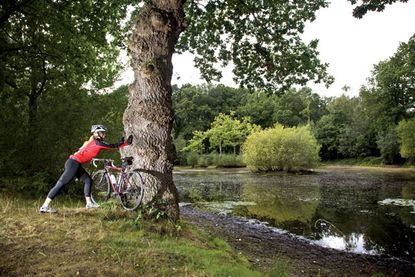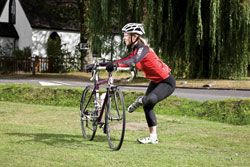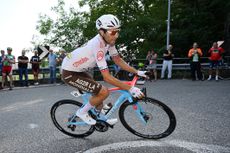Stretching techniques
Watching the Tour de France you may have spotted some arresting ‘on-bike' stretching techniques, including the kamikaze ‘downhill full quad stretch sitting on one foot'. But there are simpler ways to ease out tension from the legs, shoulders, neck, and back while you ride without risking life and limb

These ‘on-bike' stretches allow you to stretch and keep riding, with a few straightforward adjustments. For example, standing up in the saddle while you are coasting and dropping one heel down to alleviate that dull ache in the calves which is threatening to disrupt a training session. Or pausing to perform some slow shoulder rolls at a traffic light.
Alternatively, wait until you stop to refuel and use the bike as a prop. Your bike is an ideal stretching partner: the top tube is the perfect height to ease tightness out of the upper back, shoulders, quads and glutes. Lean it against a wall or tree, or use it freestanding by placing one hand on the handlebars and one on the seat.
These on-bike techniques are not designed to replace deeper post-ride recovery stretching. This is because there is simply not sufficient time while you are riding to hold a position for the 30-60 seconds that muscles (especially the hamstrings) need to restore their proper length.
This means that on-bike stretches are unlikely to reduce the onset of DOMS, or delayed onset muscle soreness, (that feeling the morning after a heavy ride when you hobble out of bed like a pensioner).
However, stretching the muscles while they are warm and receptive serves as a good quick fix. The stretch-while-you-ride techniques, such as head tilts to alleviate a sore neck, should be sufficient to keep you riding in more comfort, for longer.
Then, when you reach a rest stop, climb off and dedicate 20 more seconds to performing some off-bike stretches to stay supple and prevent the build up of lactic acid. You may well be the only one in your group stretching but consider this: you will be the only one with a fresh pair of legs for the next phase of the ride.
On the bike stretch
Reserve these on-bike techniques for a flat, traffic-free section of road. Perform the stretches while you are coasting and hold for five seconds, or as long as you feel stable and safe.
Lower body

1 Hamstrings:
Rise out of the saddle, straighten the legs and shift the hands down to the drops, bending the body into a right angle.
Keep the feet level on the pedals and lean the upper body in until you feel the hamstrings pull in the front leg. Switch legs and repeat. [left]

2 Calf:
From the hamstring stretch position bend the front leg and straighten the back leg.
Drop the heel towards the floor until you feel a deep stretch in the calf muscle.
Switch legs and repeat. [right]

3 Quads/hip flexors:
Move the hands up to the hoods and slide forward, right off the saddle.
Bend the right leg and straighten the left leg.
Push the hips forward and lean the upper body slightly back. You are aiming for a stretch in the thigh and the top of the leg where it joins the hips. Switch legs and repeat. [left]

4 Backbend:
To tackle tightness in the entire back while remaining on the bike, keep your hands on the hoods but move them to the outer edges to widen the shoulders.
Draw the shoulders back and down in a small shoulder roll, then dip in the lower back and lift the hips.
This mini pelvic tilt motion (or ‘cat stretch' in yoga) reverses the bent-double cycling position the back maintains for hours at a time on the bike. [right]
Upper Body
You probably have your own instinctive upper body movements to ease tension in the shoulders, upper back or neck muscles but, if not, here are a few suggestions. Some can be easily performed while riding. Save others for a traffic light stop when you can take both hands off the handlebars to really focus on the stretch without worrying about balance or traffic congestion. Avoid any jerky or sudden stretches.

1 Chest:
At a traffic light, pause to sit up in the saddle. Take both hands behind your back and interlace the fingers.
Either remain in this position or lift both hands up off the lower back.
This movement will really draw back the shoulders and ‘open' the chest stretching both pectoralis major and minor.
These chest muscles can shorten over time in cyclists eventually leading to protracted or rounded shoulders. [above]

2 Shoulders:
Keeping the hands resting lightly on the hoods and the arms slightly bent, perform some slow rolls by moving the shoulders in a circle.
Or shrug them by lifting the shoulders under the ears and squeezing before gradually releasing back down. [right]

3 Neck:
Tilt the head a little from side to side to stretch the sides of the neck.
Or keep your eyes on the road but tuck the chin slightly in to stretch the back of the neck to make a double chin.
Hold for a few seconds, then release. [above]
Off the bike stretch
This sequence of off-bike stretches can be done on a rest break to ease out muscular tightness from the shoulders and back and re-fresh the body for the remainder of the ride. Either lean the bike against a wall or tree or, if no such support is available, hold it still with both hands, placing one on the handlebars and one on the saddle.

1 Hip flexors:
Grip the bike with both hands taking them shoulder-width apart. Step the right foot back and bend the left leg as if performing a lunge.
Stay for 30-60 seconds pushing the hips forwards. You are looking for a stretch in the thigh and at the front of the hip; the muscles that literally lift the leg every time you pedal. Switch sides. [right]

2 Glutes:
Lift the left leg off the floor, turn the knee out and lay the left ankle on top of the right thigh.
Flex or activate the right foot to protect the knee joint.
For a more intense glute stretch sit lower but be mindful of the knee as its easy to strain in this position. [left]

3 Quads:
Place the right hand on the saddle and bend the left leg. Hold onto the left foot with the left hand, and level the knees.
Remain here for 30-60 seconds pushing the hips forwards. Gaze ahead or tuck the chin in to stretch the back of the neck.
To move deeper into the stretch, push the foot into the hand to pull it backwards as if drawing back a bow. Switch sides. [right]

4 Upper back/shoulders/hamstrings:
To release tension from the hamstrings as well as the back and shoulder muscles that maintain cycling posture, keep the hands on the bars and saddle and walk backwards until the body drops into a right-angle position.
Tuck the tailbone under and engage the abdomen in so the lower back doesn't dip. Grip the bike and draw the hips further away from the bike until the arms are stretched and you feel a decompressing effect as the spine lengthens.
Experiment with arm width by moving the hands closer for a deeper shoulder stretch or wider if it's too intense. Sway the hips slowly one way, then the other to unlock the sides of the torso and target the deep shoulder muscles. Stay for 30-60 seconds. Exit slowly by bending the knees and walking towards the bike to rise up. [above left]

5 Upper back/shoulders/calves:
For a version of the previous stretch that targets the calves and hips, keep your hands in the same position but bend the knees and lower into a deep squat so that your arms straighten.
You should be feeling a deep pull in the calves, upper back, shoulders and arms but experiment with the positioning of the feet and hands (taking them wider or closer together) until you hit those tight spots. [right]
Read Cycling Weekly magazine on the day of release wherever you are in the world International digital edition, UK digital edition. And if you like us, rate us!

Four of the best indoor cycling sessions for turbo training
The boredom of the turbo-trainer is the cyclist’s annual test of motivation: here's how to both enjoy indoor training and

Thank you for reading 20 articles this month* Join now for unlimited access
Enjoy your first month for just £1 / $1 / €1
*Read 5 free articles per month without a subscription

Join now for unlimited access
Try first month for just £1 / $1 / €1
Get The Leadout Newsletter
The latest race content, interviews, features, reviews and expert buying guides, direct to your inbox!
Founded in 1891, Cycling Weekly and its team of expert journalists brings cyclists in-depth reviews, extensive coverage of both professional and domestic racing, as well as fitness advice and 'brew a cuppa and put your feet up' features. Cycling Weekly serves its audience across a range of platforms, from good old-fashioned print to online journalism, and video.
-
 Larry Warbasse claims what could be the world's toughest Strava KOM
Larry Warbasse claims what could be the world's toughest Strava KOMThe 89.5km Mauna Kea climb in Hawaii rises from sea-level to 4,214 metres with steep gravel sections on the way
By James Shrubsall Published
-
 ‘We need to honour her memory’ - Melissa Hoskins’ parents pay tribute after Olympian’s tragic death
‘We need to honour her memory’ - Melissa Hoskins’ parents pay tribute after Olympian’s tragic deathFamily and former teammates mourn loss of Australian cyclist
By Tom Davidson Published

